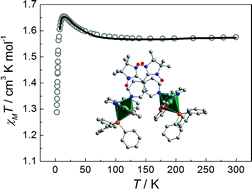Ferromagnetic interactions in Ru(iii)–nitronyl nitroxide radical complex: a potential 2p4d building block for molecular magnets†
Abstract
The reaction between [Ru(salen)(PPh3)Cl] and the

* Corresponding authors
a
L.A.M.M., Department of Chemistry and INSTM Research Unit, Università di Firenze, via della Lastruccia 3, Sesto Fiorentino, Italy
E-mail:
roberta.sessoli@unifi.it
Fax: +39 055 4573372
Tel: +39 055 4573268
b
Sciences Chimiques de Rennes, UMR 6226 CNRS-INSA Rennes, Equipe «Matériaux Inorganiques: Chimie Douce et Réactivité», INSA Rennes, 20 Avenue des Buttes de Coësmes, CS 14315, Rennes Cedex, France
E-mail:
kevin.bernot@unifi.it
Fax: +33 2 23 238438
The reaction between [Ru(salen)(PPh3)Cl] and the

 Please wait while we load your content...
Something went wrong. Try again?
Please wait while we load your content...
Something went wrong. Try again?
F. Pointillart, K. Bernot, L. Sorace, R. Sessoli and D. Gatteschi, Dalton Trans., 2007, 2689 DOI: 10.1039/B701657C
To request permission to reproduce material from this article, please go to the Copyright Clearance Center request page.
If you are an author contributing to an RSC publication, you do not need to request permission provided correct acknowledgement is given.
If you are the author of this article, you do not need to request permission to reproduce figures and diagrams provided correct acknowledgement is given. If you want to reproduce the whole article in a third-party publication (excluding your thesis/dissertation for which permission is not required) please go to the Copyright Clearance Center request page.
Read more about how to correctly acknowledge RSC content.
 Fetching data from CrossRef.
Fetching data from CrossRef.
This may take some time to load.
Loading related content
